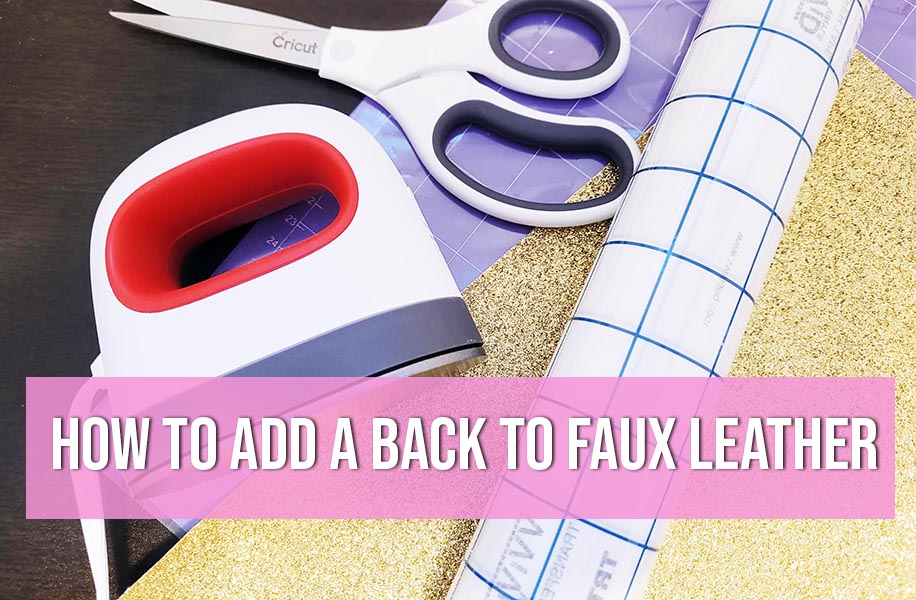If you are making your own accessories with your cricut than you probably are using some sort of faux leather. Some faux leather have decorative backs and some have plain white backs. If you are designing a piece where the back will be shown. Maybe it’s an earring that will flip while worn, or its a bow where the fabric twists and shows the back.

There are a few options depending on what final design you want to achieve. One way is to use heat transfer vinyl to iron onto the backside. This is an easy way to cover up the plain back and also add more color or pattern to your design. The second way is to use adhesive foil, this adds a glam look that is fashionable. The third way is to use iron on transfer paper, the kind that you print with your inkjet printer and can transfer designs onto light fabrics. This is a great way to add custom details like your logo or a personal greeting such as happy birthday, or a custom detailed pattern. The fourth way is to cut out a mirror of the design on a second piece of faux leather and glue it on the back. The drawback of this is that it is very bulking and may not look nice or fold easily.
Heat transfer vinyl on back of faux leather.
Use heat transfer vinyl to iron on the back of the faux leather before cutting out. Keep in mind this may make it difficult for hot glue to stick, so I recommend testing on scrap fabric before cutting out all your shapes.

Step 1. First figure out how much faux leather you will be using for you pattern. I did this by uploading the svg file to Cricut Design space and pushing the “Make it” button to see how the pattern will be arranged on the mat, this gave me the dimensions I needed.
Step 2. Cut out your faux leather and heat transfer vinyl to the dimensions.

Step 3. Using a ironing mat, a small craft iron, and some teflon sheet iron the heat transfer vinyl to the faux leather according to the manufacturers instructions.

Step 4. Place the bonded faux leather face down onto a purple strong grip cutting mat. I recommend placing some transfer tape onto the mat to help the material to grip as well as keep your mat clean so it will last longer. And use painters tape along the edge to hold the fabric in place if it still feels loose.

Step 5. Now cut out the fabric using your Cricut machine. I used the faux leather setting.

Foil backing
Foil heat transfer, this is two step application. First you apply the adhesive sheet with an iron or heat press. Second you apply the foil using an iron or heat press and it sticks directly to the fabric. I recommend cutting out the shape you want first with the faux leather as well as the adhesive and then apply the foil as apposed to apply the adhesive and foil to the faux leather and then cutting it out because it will have a jagged edge from the blade.
Step one. After choosing a design upload to Design space to see the dimensions the design will be. Now cut out a piece of faux leather, adhesive and foil a bit bigger than the design.

Step 2. cut out your shapes in design space for the faux leather and the adhesive sheet. You do not cut the foil. And weed the adhesive so that it is ready to be heat pressed. I used the premium vinyl setting for the adhesive and faux leather setting for the leather.

Step 3. With a craft iron or heat press attach the adhesive to the back of the faux leather using a teflon sheet.

Step 4. Once cool peel off the plastic backing.

Step 5. Place the foil over the adhesive back and using a craft iron or heat press and a piece of teflon paper, press the foil.

Step 6. When cool, peel off the foil sheet.

I like to put the teflon sheet back on the foil and give it another quick press because this gives the foil a texture I enjoy. But this step is optional.

Other backing ideas
Printable iron on white transfer
This is the same as you use for iron on transfer for light colored t-shirts. Just print your logo or design onto the transfer paper and then iron it on to the faux leather. Similar to this product found on amazon.
More faux leather
Adding a second sheet of faux leather on the back will make a very thick piece of material that will not fold easily so I recommend this option last. This option could work well with earrings since they twist and turn when you where them and the added thickness could be an appealing design feature.
When you cut out your design you will need to cut out a second identical peice, but make sure to mirror it before cutting. Use as small amount of craft glue between the layers and weigh it down with some books so that it dries flat. This will take several hours so leave it sit overnight. You could also use heat n bond to attach the two layers together.
If you enjoyed this post and found it helpful, please share on pintrest using the image below.



